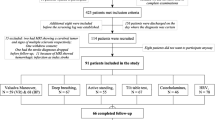Abstract
To investigate the frequency and pattern of orthostatic hypotension (OH) associated with acute isolated cerebellar infarction, and to identify the cerebellar structure(s) potentially responsible for OH, 29 patients (mean age 60.0) with acute isolated cerebellar infarction performed a standard battery of autonomic function tests including the head up tilt test using Finapres for recording of the beat-to-beat BP response during the acute period. Cerebellar infarction related OH was defined as fall in BP (>20 mmHg systolic BP) on tilting in patients without any disease(s) that could potentially cause autonomic dysfunction, or in patients who had a potential cause of autonomic dysfunction, but showed the absence of OH during a follow-up test. The severity and distribution of autonomic dysfunction were measured by the composite autonomic severity score (CASS). Nine patients (31 %) had OH (range 24–53 mmHg) on tilting during the acute period. Most patients (7/9) had a remarkable decrement in systolic BP immediately upon tilting, but OH rapidly normalized. Mean of maximal decrease in systolic BP during head up tilt test was 37.0 mmHg. The OH group showed mild autonomic dysfunctions (CASS, 3.7) with adrenergic sympathetic dysfunction appearing as the most common abnormality. Lesion subtraction analyses revealed that damage to the medial part of the superior semilunar lobule (Crus I) and tonsil was more frequent in OH group compared to non-OH group. Cerebellar infarction may cause a brief episode of OH. The medial part of the superior semilunar lobule and tonsil may participate in regulating the early BP response during orthostasis.


Similar content being viewed by others
References
(1996) Consensus statement on the definition of orthostatic hypotension, pure autonomic failure, and multiple system atrophy. The Consensus Committee of the American Autonomic Society and the American Academy of Neurology. Neurology 46:1470
Claydon VE, Steeves JD, Krassioukov A (2006) Orthostatic hypotension following spinal cord injury: understanding clinical pathophysiology. Spinal Cord 44:341–351
Hsu CY, Hogan EL, Wingfield W Jr et al (1984) Orthostatic hypotension with brainstem tumors. Neurology 34:1137–1143
Bradley DJ, Pascoe JP, Paton JF, Spyer KM (1987) Cardiovascular and respiratory responses evoked from the posterior cerebellar cortex and fastigial nucleus in the cat. J Physiol 393:107–121
Chen CH, Williams JL, Lutherer LO (1994) Cerebellar lesions alter autonomic responses to transient isovolaemic changes in arterial pressure in anaesthetized cats. Clin Auton Res 4:263–272
Yates BJ, Miller DM (2009) Integration of nonlabyrinthine inputs by the vestibular system: role in compensation following bilateral damage to the inner ear. J Vestib Res 19(183–18):9
Holmes MJ, Cotter LA, Arendt HE, Cass SP, Yates BJ (2002) Effects of lesions of the caudal cerebellar vermis on cardiovascular regulation in awake cats. Brain Res 938:62–72
Miller DM, Cotter LA, Gandhi NJ et al (2008) Responses of rostral fastigial nucleus neurons of conscious cats to rotations in vertical planes. Neuroscience 155(317–3):25
Ruchoux MM, Gray F, Gherardi R, Schaeffer A, Comoy J, Poirier J (1986) Orthostatic hypotension from a cerebellar gangliocytoma (Lhermitte-Duclos disease). Case report. J Neurosurg 65:245–248
Lee H, Kim HA (2014) Reversible orthostatic hypotension in PICA territory cerebellar infarction. J Neurol Sci 341:187–188
Tatu L, Moulin T, Bogousslavsky J, Duvernoy H (1996) Arterial territories of human brain: brainstem and cerebellum. Neurology 47:1125–1135
Low PA, Benarroch EE (2008) Clinical autonomic disorders, 3rd edn. Lippincott Williams & Wilkins, Philadelphia
Kim HA, Yi HA, Lee H (2014) Spectrum of autonomic dysfunction in orthostatic dizziness. Clin Neurophysiol 125:1248–1254
Low PA (1993) Composite autonomic scoring scale for laboratory quantification of generalized autonomic failure. Mayo Clin Proc 68:748–752
Diedrichsen J (2006) A spatially unbiased atlas template of the human cerebellum. Neuroimage 33:127–138
Diedrichsen J, Balsters JH, Flavell J, Cussans E, Ramnani N (2009) A probabilistic MR atlas of the human cerebellum. Neuroimage 46:39–46
Baier B, Dieterich M (2011) Incidence and anatomy of gaze-evoked nystagmus in patients with cerebellar lesions. Neurology 76:361–365
Zee DS, Yamazaki A, Butler PH, Gucer G (1981) Effects of ablation of flocculus and paraflocculus of eye movements in primate. J Neurophysiol 46:878–899
Press GA, Murakami J, Courchesne E et al (1989) The cerebellum in sagittal plane-anatomic-MR correlation: 2. The cerebellar hemispheres. AJR Am J Roentgenol 153:837–846
Zhu JN, Yung WH, Kwok-Chong Chow B, Chan YS, Wang JJ (2006) The cerebellar-hypothalamic circuits: potential pathways underlying cerebellar involvement in somatic-visceral integration. Brain Res Rev 52:93–106
Wieling W, Krediet CT, van Dijk N, Linzer M, Tschakovsky ME (2007) Initial orthostatic hypotension: review of a forgotten condition. Clin Sci (Lond) 112:157–165
Jian BJ, Cotter LA, Emanuel BA, Cass SP (1985) Yates BJ (1999) Effects of bilateral vestibular lesions on orthostatic tolerance in awake cats. J Appl Physiol 86:1552–1560
Mori RL, Cotter LA, Arendt HE, Olsheski CJ, Yates BJ (1985) Effects of bilateral vestibular nucleus lesions on cardiovascular regulation in conscious cats. J Appl Physiol 98:526–533
Ward C, Kenny RA (1996) Reproducibility of orthostatic hypotension in symptomatic elderly. Am J Med 100:418–422
Author information
Authors and Affiliations
Corresponding author
Ethics declarations
Ethical standard
All of the experiments complied with the tenets of the Declaration of Helsinki and the study protocol was reviewed and approved by our institutional review board. Written informed consent was obtained from patients with acute cerebellar infarction after the nature and possible consequences of the study had been explained to the participants.
Conflicts of interest
None.
Source of funding
This work was supported by the National Research Foundation of Korea (NRF) Grant funded by the Korea Government (MSIP) (No. 2014R1A5A2010008).
Rights and permissions
About this article
Cite this article
Kim, HA., Lee, H. Orthostatic hypotension in acute cerebellar infarction. J Neurol 263, 120–126 (2016). https://doi.org/10.1007/s00415-015-7945-7
Received:
Revised:
Accepted:
Published:
Issue Date:
DOI: https://doi.org/10.1007/s00415-015-7945-7




